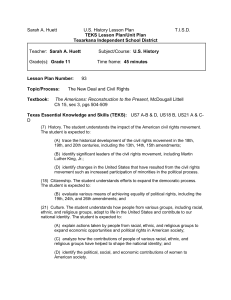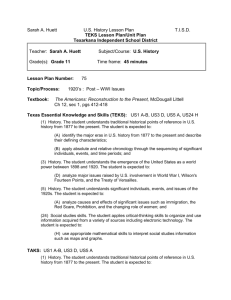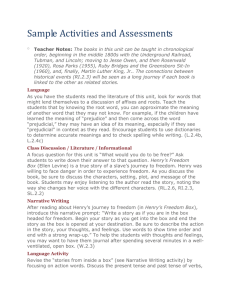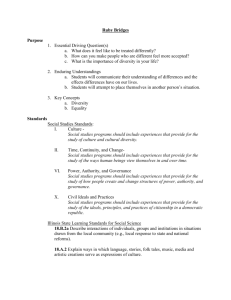Lesson Plan 123 - Texarkana Independent School District
advertisement
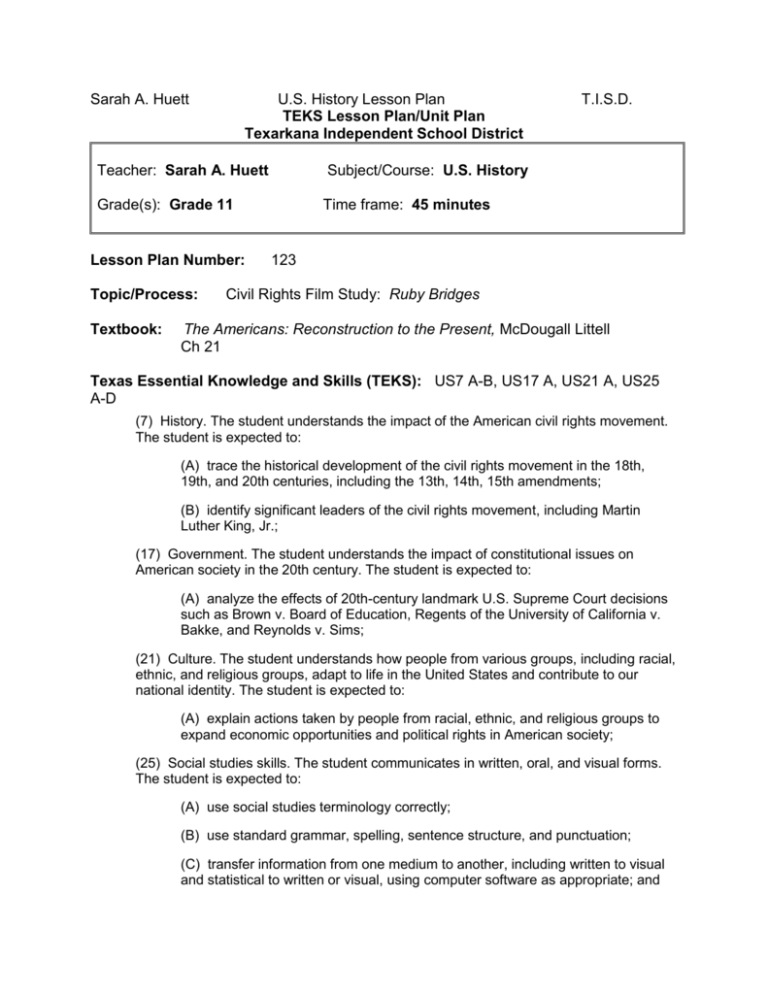
Sarah A. Huett U.S. History Lesson Plan TEKS Lesson Plan/Unit Plan Texarkana Independent School District Teacher: Sarah A. Huett Subject/Course: U.S. History Grade(s): Grade 11 Time frame: 45 minutes Lesson Plan Number: Topic/Process: Textbook: T.I.S.D. 123 Civil Rights Film Study: Ruby Bridges The Americans: Reconstruction to the Present, McDougall Littell Ch 21 Texas Essential Knowledge and Skills (TEKS): US7 A-B, US17 A, US21 A, US25 A-D (7) History. The student understands the impact of the American civil rights movement. The student is expected to: (A) trace the historical development of the civil rights movement in the 18th, 19th, and 20th centuries, including the 13th, 14th, 15th amendments; (B) identify significant leaders of the civil rights movement, including Martin Luther King, Jr.; (17) Government. The student understands the impact of constitutional issues on American society in the 20th century. The student is expected to: (A) analyze the effects of 20th-century landmark U.S. Supreme Court decisions such as Brown v. Board of Education, Regents of the University of California v. Bakke, and Reynolds v. Sims; (21) Culture. The student understands how people from various groups, including racial, ethnic, and religious groups, adapt to life in the United States and contribute to our national identity. The student is expected to: (A) explain actions taken by people from racial, ethnic, and religious groups to expand economic opportunities and political rights in American society; (25) Social studies skills. The student communicates in written, oral, and visual forms. The student is expected to: (A) use social studies terminology correctly; (B) use standard grammar, spelling, sentence structure, and punctuation; (C) transfer information from one medium to another, including written to visual and statistical to written or visual, using computer software as appropriate; and Sarah A. Huett U.S. History Lesson Plan T.I.S.D. (D) create written, oral, and visual presentations of social studies information. TAKS: US7 A-B, US17 A, US21 A (7) History. The student understands the impact of the American civil rights movement. The student is expected to: (A) trace the historical development of the civil rights movement in the 18th, 19th, and 20th centuries, including the 13th, 14th, 15th amendments; (B) identify significant leaders of the civil rights movement, including Martin Luther King, Jr.; (17) Government. The student understands the impact of constitutional issues on American society in the 20th century. The student is expected to: (A) analyze the effects of 20th-century landmark U.S. Supreme Court decisions such as Brown v. Board of Education, Regents of the University of California v. Bakke, and Reynolds v. Sims; (21) Culture. The student understands how people from various groups, including racial, ethnic, and religious groups, adapt to life in the United States and contribute to our national identity. The student is expected to: (A) explain actions taken by people from racial, ethnic, and religious groups to expand economic opportunities and political rights in American society; Concepts Enduring Understandings/Generalizations/Principles The student will understand that Conflict Cultural diversity can lead to conflict. Differences between people create conflict. Social, economic and political oppression often lead to conflict. Change often occurs as a result of conflict. Change is inevitable. Change can be positive or negative. The desire for equality may lead to conflict and change. True equality often does not exist. Change Equality Sequence of Activities (Instructional Strategies): 1. Background of Film: Give students a little bit of background on Ruby Bridges, this information can be found at the Ruby Bridges Foundation website. Give students their film study. Be sure to include questions on the film study that relate to Brown vs. Board of Education and the Little Rock Crisis. Begin watching film. Sarah A. Huett U.S. History Lesson Plan Questions to Consider in Lesson: T.I.S.D. 1) How is Ruby Bridges chosen to integrate the New Orleans Schools? 2) How do Ruby’s parents feel about her task? Assessment of Activities: Classroom Observation Classroom Discussion Film Study/Essay Prerequisite Skills: 1. Character Analysis Skills 2. Writing Skills Key Vocabulary: N/A Materials/Resources Needed: Copy of Ruby Bridges, TV, VCR or DVD, copies of film study Modifications: Allow students to have extended time to complete activities. Follow all modifications on students IEP. Subtitles if necessary. Differentiated Instruction: Have students research Ruby Bridges’ website. Have students compile a list of questions they would like to ask Ruby. Teacher Notes: Sample Test Questions: 1. What landmark Supreme Court case allowed Ruby Bridges to go and integrate the New Orleans Public Schools? A. B. C. D. Plessy vs. Ferguson Roe vs. Wade Brown vs. Topeka Kansas Board of Education Dred Scott vs. Sanford Sarah A. Huett U.S. History Lesson Plan T.I.S.D. 2. How was Ruby Bridges and many other young African-Americans chosen to integrate public schools? Project developed and delivered through a Collaborative Research Grant between Texarkana Independent School District and TAMU-T Regents’ Initiative.

